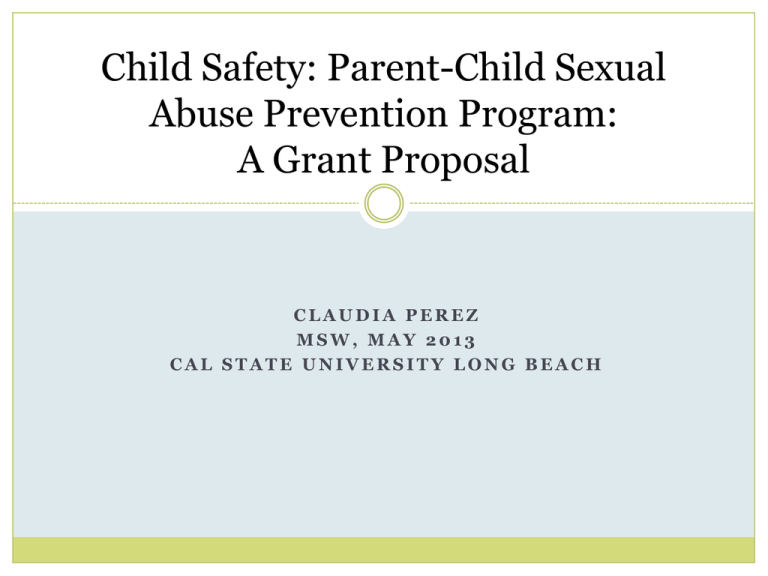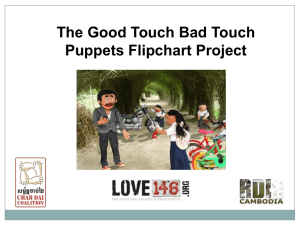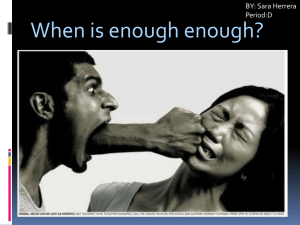
Child Safety: Parent-Child Sexual
Abuse Prevention Program:
A Grant Proposal
CLAUDIA PEREZ
MSW, MAY 2013
CAL STATE UNIVERSITY LONG BEACH
Introduction
The purpose of this project is to discuss the problem of child
sexual abuse, particularly within the Latino culture and to show
the benefits of my grant proposal: Child Safety: Parent-Children
Sexual Abuse Prevention Program.
Among the child sexual abuse reports, the California Department
of Social Services (CDSS) (2011) accounted for 20,452 Hispanic
victims of child sexual abuse under the age of 17 years old in
California.
Child abuse figures for Hispanics are nearly two times higher
than Whites, approximately four times higher than Blacks, and
over twenty times higher than Asians (CDSS, 2011).
The goals of this program are: To educate families and children
about child sexual abuse, and to implement culturally competent
material. Upon successful completion of this program the
parents and children should meet the program objectives.
Social Work Relevance
Social workers’ mission and responsibility is to advocate on
behalf of vulnerable populations who are being abused or who
are at-risk of being abused (National Association of Social
Workers [NASW], 2008).
Social workers and their support of alternative prevention
efforts is part of the continuing fight against child sexual
abuse.
Supporting prevention programs can also allow these
programs to show their potential effectiveness in child sexual
abuse prevention.
Child sexual abuse prevention programs can be a beneficial
resource social workers can use for at risk families or for
children/families already in treatment.
Multicultural Relevance
Child sexual abuse does not discriminate between
any cultures, age, or sex; several reports have shown
a higher number of child sexual abuse cases among
the Hispanic population than Whites, Blacks, and
Asians (CDSS, 2011; Newcomb et al., 2009).
Providing the community with alternative and
effective ways of preventing child sexual abuse is
acknowledged as a societal need (AACAP, 2012).
Methods
The program will be designed to serve families of Latino origin.
The 6 week curriculum program will accommodate 20 children between the
ages of 4 to 6 and their parents or their caregivers.
Potential sources to fund the proposed project were found through the use
of search engines. Key terms such as “child abuse prevention grants” and
“child sexual abuse program grants” were used to locate potential funding
sources or information on possible funding sources.
A non-profit library was also visited for further guidance on how to locate
and access federal and state grants.
Weingart Foundation was identified to be the most suitable funding option
for this project.
Methods
A needs assessment of the target population was made possible through the use
of recently published journal articles on child sexual abuse. This material was
located through the academic library database of California State University,
Long Beach. The search engines Google and Yahoo were also used to access
government websites such as the U. S. Department of Human Health and
Services and the California Department of Social Services for statistical
information on the topic of child sexual abuse.
The approximate amount it will take to launch and support this program is
14,000. This amount will cover the following expenses:
Salaries: 11,000
Materials: 2,300
Equipment: In-kind Expenses
Grant Proposal
The 6 week program is designed to educate parents and children
about child anatomy, inappropriate and appropriate touching,
predator grooming tactics, promote parent and child
communication, and to help prevent child sexual abuse.
This program will target Latino families with children 4-6 years
old. These families should be of low-income and live in the
underserved areas of Los Angeles County. This program is
designed to educate Latino families about child sexual abuse in
an effort decline the abuse.
The host agency, Maternal and Child Health Access, will seek
additional funding to sustain the program based on the pilot
program’s outcomes.
Grant Proposal
The program objectives are:
(1) Educate parents and children about the definitions of child sexual abuse.
(2) Educate parents and children on perpetrator characteristics and coaxing tactics.
(3) Provide parents and children the appropriate language and skills to talk about
child anatomy, inappropriate and appropriate touching, and child sexual abuse.
(4) Increase parent-child communication and comfort level with the topic of child
sexual abuse.
The facilitators of this group will implement a pre and post-test Likert-type
survey to measure the program objectives. The pre-test will measure group members’
knowledge of child sexual abuse before the program. This survey will also establish a base-line measure for
post-test comparison. A post-test will be implemented to measure group members’ knowledge of child sexual
abuse upon completion of the program. These surveys are designed to be self-administered; however, the
children participants will be interviewed.
The surveys will focus on the following:
Child sexual abuse awareness (what it is, perpetrators, and grooming tactics).
Parent-child comfort level with the topic of child sexual abuse.
Parent-child use of child sexual abuse discussions and prevention measures.
Parent-child use of child anatomy identification and discussions.
Lessons Learned
Culturally specific studies about Latinos were difficult to locate. This made
it challenging for the grant writer to document the benefits of developing
and implementing culturally-based child sexual abuse prevention
programs.
Through this process, the grant writer became aware of, and familiar with,
foundations, organizations, and charities that offer grant funding. In
addition, the grant writer learned about the multiple criteria required and
the art of composing a grant application. Through this experience, the
writer became knowledgeable and comfortable with the process of grant
writing.
It is important to highlight that several studies in the literature review of
this grant application recognized the need for culturally relevant studies.
These studies acknowledged cultural uniqueness in the topic of child sexual
abuse and the benefits of exploring cultural relevancy.
References
American Academy of Child & Adolescent Psychiatry. (2012).
Facts for families: Child sexual abuse. Retrieved from
www.aacap.org
California Department of Social Services. (2009). Child abuse
prevention, intervention, and treatment (CAPIT) program.
Retrieved from http://www.childsworld.ca.gov/PG2287.htm
National Association of Social Workers. (2008). Code of Ethics of
the National Association of Social Workers. Retrieved from
http://www.naswdc.org/pubs/code/code.asp
Newcomb, M. D., Munoz, D. T., & Carmona, J. V. (2009). Child
sexual abuse consequences in community samples of Latino and
European American adolescents. Child Abuse & Neglect, 33, 533544.









